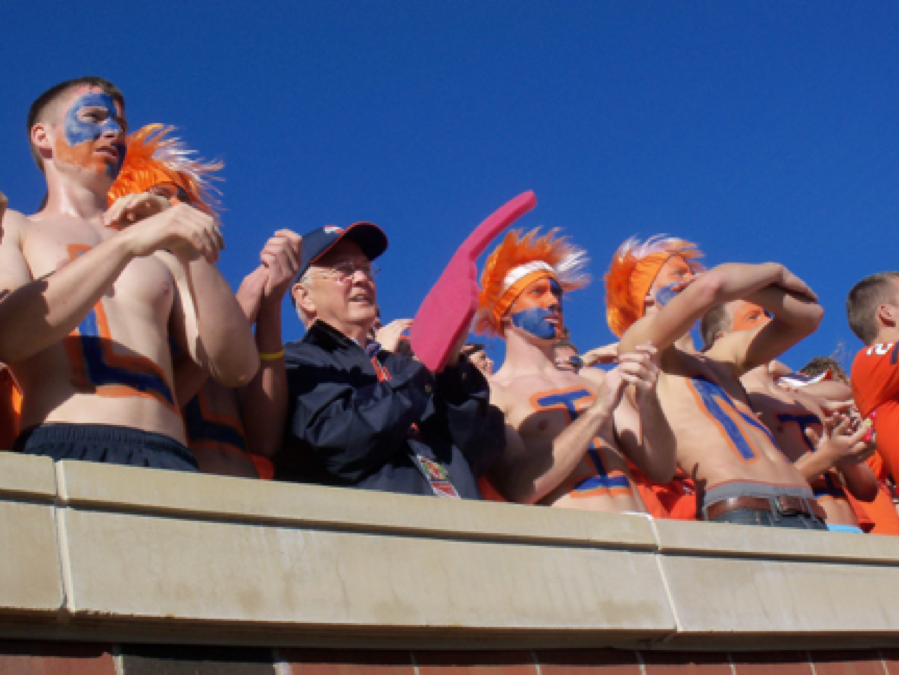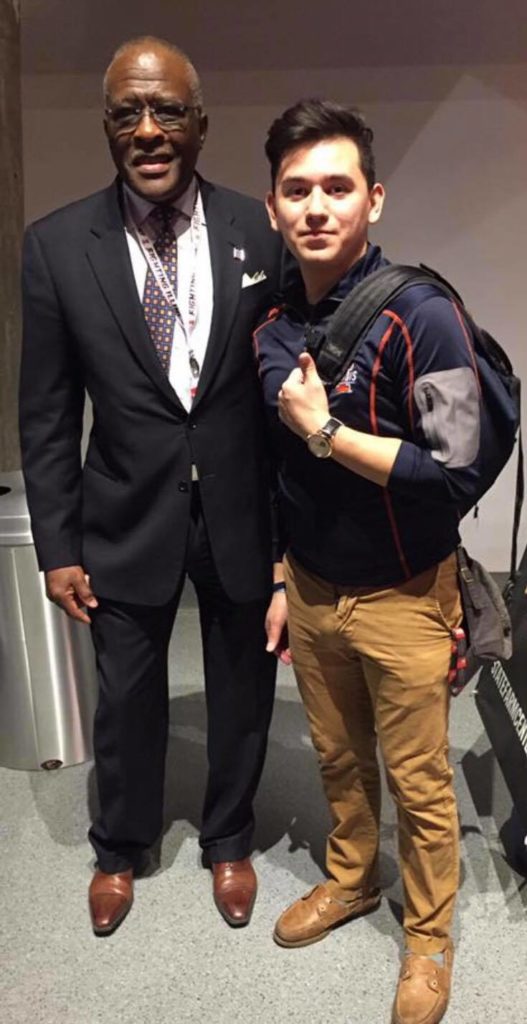
Former U of I President Michael Hogan (2010-2012) with pro-Chief students.
On March 13, 2007, the University of Illinois Board of Trustees, after approximately 20 years of debate on the Illiniwek tradition, directed
“… the immediate conclusion to the use of Native American imagery as the symbol of the University of Illinois and its intercollegiate athletics along with the related regalia, logo, and the names ‘Chief Illiniwek’ and ‘Chief, and … [that] the Chancellor of the Urbana-Champaign campus manage the final disposition of these matters.”
Many Trustees acted not out of concern for American Indians but because the NCAA, after seven years of careful study, established a policy prohibiting the use of American Indian imagery in intercollegiate sports. The Trustees had been warned both from within and outside their ranks to resolve this issue through their own initiative, but they lacked the will to do so. The 2007 policy was a resounding repudiation of those Trustees and politicians who had undermined the will of the university’s administration, faculty and students for decades. As the News-Gazette stated at the time, “If it wasn’t for a few well-placed politicians the mascot would have been gone by now.”
Although the 2007 resolution stated that “this Resolution concludes the Board’s consensus process regarding the matter of the Chief Illiniwek tradition,” that has not been the case. To date the Board, abetted by the administration, continues to undermine the fulfillment of its own policy.
It is now twelve years, five chancellors, four presidents, numerous scandals, and an incalculable number of administrative references to a commitment to “diversity” later. During this interim, Chancellor Richard Herman did as little as possible to fulfill the Board’s policy. Chancellor Robert Easter formulated a plan for the Urbana campus to establish a new mascot. That initiative was quashed.
Subsequently, Chancellor Phyllis Wise promised that “the Chief was not coming back,” but simultaneously attempted to cultivate the favor of the Peoria Tribe of Indians of Oklahoma. According to NCAA guidelines, an endorsement from the Peoria could allow the university to reestablish its race-based Indian mascot. But the Peoria did not buy into this 500-year-old ploy; they continue to maintain, “Chief Illiniwek does not … honor the heritage of the Peoria Tribe … and is a degrading racial stereotype that reflects negatively on all American Indian people.”
Wise’s successor Barbara Wilson engaged UIUC students to determine whether there was widespread support to establish a new mascot and whether it was the right moment to do so. The students overwhelmingly concluded that it was. In a transparent and inclusive process, the Illinois Student Senate Committee on the Exploration of a New Mascot welcomed testimony from all constituencies, including alumni, students, faculty, staff, Marching Illini, and the Student Athletic Advisory Board. In 2016 the Committee recommended that “the University of Illinois at Urbana-Champaign put forth a process to select a mascot.” Their recommendation specified the selection process include broad representation, transparency, and education of all constituencies. That recommendation was affirmed in 2017 by the Illinois Student Government and Urbana Campus Senate.
Rather than initiating such a process, Chancellor Robert Jones called for more discussion. In doing so, he imparted moral equivalence and legitimacy to both sides of the debate. There are no moral arguments to upholding racism. Those who embolden morally bankrupt behavior, whether in Charlottesville, VA or Urbana, IL, do an enormous disservice to the institutions and people they are charged to serve.

UIUC Chancellor Robert Jones and Chief Illiniwek Omar Cruz at State Farm Center, prior to the Chief’s performance. Omar Cruz is a member of Chancellor Jones’ Commission on Native Imagery: Healing and Reconciliation. Note that SFC policy prohibits backpacks in the arena.
An incredible amount of discussion preceded the 2007 Trustees resolution to end the Illiniwek tradition. Many forums were held to discuss the Chief and the use of Native American imagery, and tens of thousands of documents were submitted to the Trustees and administration. In 1998, the UIUC Senate voted 97 to 29 to end the use of American Indian imagery by the university’s athletic program, and a petition to that effect was signed by more than 800 UIUC faculty. Every student organization representing people of color has opposed UIUC’s use of a race-based mascot/symbol, as have numerous campus departments.
Many Native American organizations and tribes as well as local and national civil rights, educational, and religious organizations weighed in, including the National Congress of American Indians, the American Psychological Association, the NAACP, the NCAA, the Higher Learning Commission, and the United States Commission on Civil Rights. A United States House of Representatives hearing was even held in Champaign on the issue in 2006.
No educational, civil rights or religious organization supports the continued use of Native American imagery and culture as sports entertainment. Such notable individuals as Chief of the Cherokee Nation Wilma Mankiller, Dennis Banks, Julian Bond, Mary Francis Berry, U.S. Senator Paul Simon, Chief of the Peoria Tribe John Froman, and many, many others have articulated strong opposition to the Chief during their visits to campus over the past several decades.
Instead of acting in concert with his students and faculty recommendations, Chancellor Jones, after holding what he dubbed “critical conversations,” announced he will convene a commission and extend consideration for up to five more years! Jones recently told the News-Gazette, “We are not going to avoid the issue of discussing a mascot, but it has to be done in a very thoughtful way, with more input. … We are not saying absolutely no [to a new mascot] at this point. But it’s a complex issue. We just need additional time and analysis to decide if that’s something we’re going to pursue or not.”
It’s hard to imagine what is left to discuss.
Jones’s report on his “critical conversations” contained absolutely no new information. In fact, many suggestions had previously been presented numerous times and rejected by the administration and Trustees. These include a clear and honest public explanation of why it was deemed in the interest of the University to retire Chief Illiniwek, education of all constituencies about the Illiniwek tradition, and reestablishing the original meaning of Fighting Illini (a compromise with the NCAA that allowed continued use of the moniker). The administration and Trustees have also refused to uphold legal agreements and university property rights violated by Students for Chief Illiniwek, the Honor the Chief Society and the ad hoc self-appointed Council of Chiefs.
Will Chancellor Jones move the dial or engage in yet another charade? After Jones and Athletic Director Josh Whitman laudably ended the university band’s playing of its faux Indian War Chant, they were severely reprimanded by the University Board of Trustees. Let’s see how the Trustees respond to any new initiative. Trustees Ed McMillan and Stuart King, with the blessing of then-Board Chair Tim Koritz, recently visited the Peoria Tribe with new offerings. Given the Board’s history on this issue and Mr. McMillan being a favorite of Students for Chief Illiniwek, it is clear this trip was made not out of genuine concern for the Peoria people but as yet another attempt to conjure their favor.
There is good reason to be skeptical about whether the Trustees will endorse any initiative proffered by Chancellor Jones to establish a new mascot. A recent editorial in the News-Gazette called the “critical conversations” “a magnificent waste of time that will continue until someone in charge finally wises up.” The real question is, who is in charge?
The failure to fully resolve the Illiniwek issue continues to negatively impact the campus racial climate and the success of Illinois athletics. Statements from students over many years indicate UIUC is not as welcoming to minority students as one would like. The unresolved issues surrounding Illiniwek, including the university-sponsored Three-In-One music at sports events, the continued sale of Illiniwek merchandise, and the recent university endorsement of the Chicago Blackhawks, all contribute to this hostile environment. And, this unwelcoming environment gets transmitted to potential students by the media and by current students. It impedes the recruitment of the best student athletes and negatively impacts the success of UIUC’s athletic programs.
Moreover, continued failure to comport with the NCAA’s policies on non-discrimination and ethical conduct, and the Higher Learning Commission’s principles on ethical and responsible conduct, may compromise the athletic and academic accreditation of the Urbana campus. Further delays in establishing a new mascot and traditions will continue to have broad negative consequences and will preclude UIUC from becoming a campus welcoming to all.
Stephen Kaufman, Ph.D., Emeritus Professor of Cell and Developmental
Biology, taught and ran a successful, well-funded research program at
the University of Illinois from 1974 to 2007. He resides in Urbana, IL
with his wife and exuberant standard poodle.

